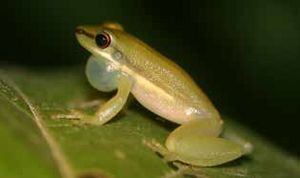Maracaibo Basin treefrog facts for kids
Quick facts for kids Maracaibo Basin treefrog |
|
|---|---|
 |
|
| Male calling | |
| Conservation status | |
| Scientific classification | |
| Synonyms | |
|
Hyla vigilans Solano, 1971 |
The Maracaibo Basin treefrog (scientific name: Scarthyla vigilans) is a small frog that belongs to the Hylidae family, also known as the treefrog family. You can find this special frog in parts of northern Colombia, northern Venezuela, and the island of Trinidad.
Scientists once debated which group this frog belonged to. However, new studies looking at its DNA (molecular data) have shown that it is closely related to another frog called Scarthyla goinorum. This means it fits well into the Scarthyla group. Even though adult Maracaibo Basin treefrogs look very similar to Scarthyla goinorum, their unique male calls and tadpoles help scientists tell them apart.
Contents
What Does the Maracaibo Basin Treefrog Look Like?
These are truly tiny frogs! The largest ones grow to about 21 mm (0.8 in) long from their snout (nose) to their vent (bottom). They have a long, thin body.
Their head is about as wide as their body, but it's a bit longer than it is wide. They have a pointed snout. Their eyes are a good size and stick out a little. You can see their eardrum (called the tympanum), even though a small fold of skin might hide part of it.
Their fingers and toes are thin and have small, round pads at the ends. Their fingers do not have webbing, but their toes are webbed, which helps them move in water.
Color Changes
At night, these frogs are a bright lime green with faint stripes. Their belly area is clear, so you can sometimes see through it! During the day, their colors become more noticeable and stand out more.
Male Calls
Male Maracaibo Basin treefrogs have a special pouch under their throat called a vocal sac. They use this to make calls. Their call sounds a lot like a cricket chirping and is very quiet. Sometimes, people might even mistake their call for an insect!
Tadpoles
The tadpoles of the Maracaibo Basin treefrog have a short, round body and a tail that is not too long. The biggest tadpoles can reach a total length of about 32 mm (1.3 in).
Where Do Maracaibo Basin Treefrogs Live?
These frogs live in open, flat areas, especially in lowlands. This includes grassy fields that sometimes flood, areas where plants have been removed but some low plants remain, and shallow pools of standing water. They lay their eggs and breed in still water and swamps.
They usually live at lower elevations, but some have been found up to about 600 m (2,000 ft) above sea level.
A Common but Shy Frog
The Maracaibo Basin treefrog is actually very common. However, it is hard to spot because it is active at night and very small. Its quiet call can also be easily covered up by the louder calls of other frogs.
Conservation Status
This frog is very good at adapting to different environments. Scientists do not believe it is currently facing any major threats. It can even be found in some protected natural areas.
See also
 In Spanish: Ranita Vigilante para niños
In Spanish: Ranita Vigilante para niños


